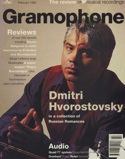Texte paru dans: / Appeared in: |
|
|
Reviewer: Julie
Anne Sadie Delight but not surprise should greet this recording of instrumental music from Marin Marais's most successful opera , bearing in mind the acclaim generated by Marc Minkowski's Erato recording of the opera (4/92) and Jordi Savall's soundtrack for thee film, Tous les matins du monde. Savall has selected movements from the prologue and each of the five acts, grouping them effectively into four 'suites'. They range from the ceremonial to the sublime and include the Overture, the "Symphonie pour Ie sommeil " and the famous raging "Tempete" from Act 4 and, of course, the graceful Chaconne that ends the opera.
A comparison of the two recordings-Savall's and Minkowski's - proves instructive. Although the excerpts are supported by a masterful note by the acknowledged French authority on Marais, Jerome de la Gorce, and Savall has ascribed more elaborate titles to characterize further the airs and dances, Marais's music must stand on it s own in these performances by Le Concert des Nations. The very fact that the musician s must 'sell' what is largely Marais 's incidental music as eminently listenable to in its own right puts them on their mettle . With this in mind I returned to the Minkowski recording and was surprised to discover the extent to which the musicians (an entirely different band) depended on the singers and the story to carry the day.
One performance is on an appropriately operatic scale while the other is merely(!) large-scale chamber music. As one of the greatest exponents of the solo viol tradition perfected by Marais, Savall focuses his insights upon this music and interprets the scoring as Marais might have done. He experiments with all the chamber-music combinations of the day and, typically, hazards some of his own , particularly in the Chaconne. Occasionally, Savall uses winds where Minkowski used strings, as in the Act I " Menuet pour les Eoliens et les Eoliennes " or the deeply affecting " Ritournelle" from Act .5 (I much prefer the strings because of the inner gravitas they enhance); occasionally Savall miscalculates his effects, as in the "Bourrée pour les Bergers et Bergères" . His command of Maraisian ornamentation is, however, everywhere evident and indeed very welcome because of the constant melodic echoes of the solo repertoire in the opera score. With chamber music come more transparent textures, revealing the harmonic and textural richness of the post-Lullian style; cross-rhythms, syncopations and sequences have more impact. By contrast, the opera performances are often sluggish and four- square.
Savall also includes music that was left out of the opera recording, including the delicately syncopated "Air pour Ies Faunes et les Driades" from the Prologue, the exquisitely scored Sarabande, with its beautifully shaded cadences, and the Gigue from Act I as well as the "Sarabande pour les Pretresses de Junon" from Act 2. In the " Menuets pour les Bergers et Bergeres" in the Prologue and the March and Air "pour les Matelots" in Act 3, Savall orchestrates passages that were once vocal solos to maintain the proportions of the movements.
Both conductors deal effectively with the “Tempete" . Minkowski has the advantage of numbers, but as a result cannot attempt the speed that Savall's enlarged chamber ensemble can. That said, Savall drives his musicians as mercilessly as the wind, enhancing the terrifying spectre with artfully marshalled - rather electronic-sounding effects where Minkowski had relied on slack-headed drums. Given the chance, I would own both of these recordings.
|
|
|
|
|
|
Cliquez l'un ou l'autre
bouton pour découvrir bien d'autres critiques de CD |
|




